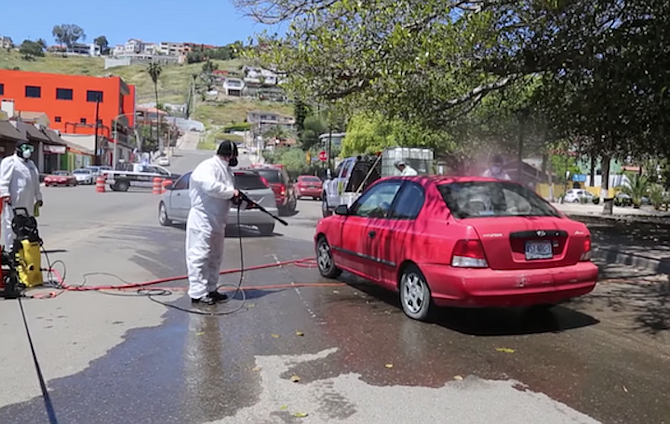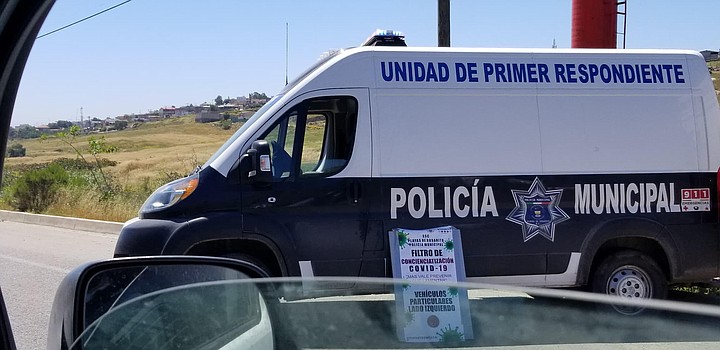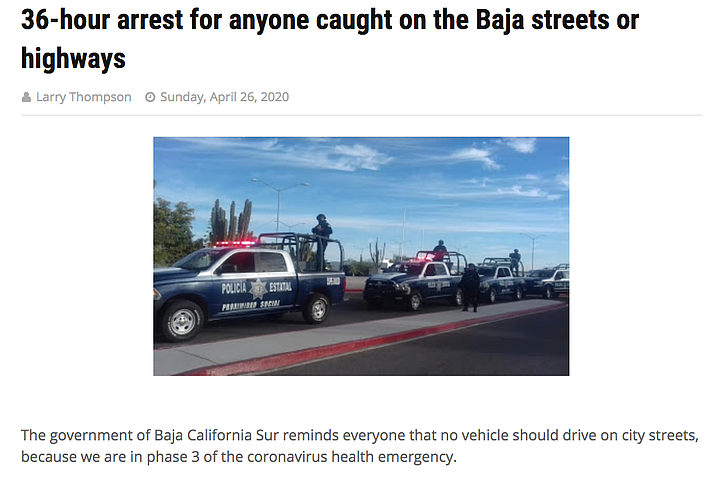 Facebook
Facebook
 X
X
 Instagram
Instagram
 TikTok
TikTok
 Youtube
Youtube

In the next few days, Ann Reid and her husband will trek from their Ensenada home to San Diego to pick up their mail and shop for essentials not available in Ensenada. The transplants are concerned about checkpoints and roadblocks north towards San Ysidro — and more so the roughly 75 mile return drive back home to Ensenada.
“The checkpoint is at El Sauzal (north Ensenada),” Reid said to me on April 26, “but they moved it nearer to the toll booth. Its original location was causing severe traffic backups and at its new location, apparently the flow is better.”

On April 20, Armando Ayala Robles, the municipal president of Ensenada, restricted access into the port city — allowing only travelers that have/had an emergency, health issues, jobs, and to transport food and medicine supplies — and to those who live there.
“At the checkpoint coming into Ensenada, they ask for your ID,” said Alex, “and if you aren’t from Ensenada, and it’s not for [the aforementioned reasons], they are not letting you in, and they tell you to return towards the toll booth.”
(Other Ensenadans reportedly bring copies of their electric bills to prove their residency.)

Alex is a Mexican national that’s been driving trucks and cargo vans for an Ensenada transport company for over 25 years. On April 22, he made a delivery to San Diego, then returned to Ensenada the same day.
“I was stuck in traffic for an hour and a half after the third toll booth,” he explained to me. “Then I pulled up to the checkpoint and the officials checked my temperature with a gun looking [handheld device]. You don’t have to get out of the vehicle unless your temperature is higher than 37-38 degrees (Celsius).”
“Did you pass?” I asked; “of course,” he responded.

If you live in Ensenada and have a fever at the checkpoint “you have two choices,” Reid explained, “you can continue into the city and be subjected to to their incoming protocol, which includes two weeks of mandatory quarantine, or you could turn around.”
While many Ensenadans grow uneasy and irate waiting in traffic to return home, others are saying “it’s worth the wait” and that the filter protocol where they use a “phaser-gun styled” device, is keeping the port city of approximately 800,000 residents, lower in positive COVID-19 cases and related deaths compared to Mexicali and Tijuana. The simultaneous check of temperatures and home address retrievals, provides the city with a log of locals that “might” have the coronavirus.
“And I believe, that they will come around to check on you (during quarantine),” Reid continued.
As this article goes to print, reports are showing that Ensenada has 30 confirmed COVID-19 cases, and five deaths attributed to the virus; Tijuana has 737 cases and 120 deaths; Mexicali has 471 cases and 40 deaths. Expats are saying this is underestimated because of lack of testing facilities in the cities in February and March.
Alex said he spoke with one of the soldiers during his 1.5 hour wait at the Ensenada checkpoint last week.
“The soldier said the wait was long because an ambulance from Tijuana arrived at the filter station with cadavers where they [supposedly] died from COVID-19,” Alex recounted, “and the ambulance driver was instructed by a Tijuana hospital to bring the remains into Ensenada for cremation purposes. The soldier [said they] didn’t allow the ambulance in, and made the driver return to Tijuana.”
On April 23, Rosarito-based American Diego Knight, posted a video that his co-workers from the Infonort news outlet produced. It was a segment on “Chlorine Pa’la Baja,” an Ensenada event that occurred earlier that day where they sanitized more than 400 vehicles with about 200 liters of chlorine. The disinfecting process, was reportedly implemented at an Ensenada fire station and in the recreational areas of a general hospital where patients with COVID-19 are treated.
“Regarding Ensenada, it’s more serious than here in Rosarito,” Knight said, “from 9 pm to 6 am, there’s a policy there deterring anyone from going outside of their houses.”
“And what about checkpoints coming into Rosarito,” I asked Knight.
“Going down the free road from Tijuana to Rosarito, there is a checkpoint,” he responded. “They ask why we are coming in, and check it we have a mask; we went through it today (April 26) and we had masks on and no problem.”
“I saw a couple who were tourists in downtown Rosarito yesterday and I know since I recognized the Rosarito Beach Hotel red bracelet. If you have that bracelet, you can go to the swimming pool.”
I reached out to another American that crossed the same Ensenada checkpoint on April 24, as of presstime she didn’t respond — she did post in part on Facebook: “This morning we went through about 8:45 am …. I asked the nurse and military officer about the three cases of ill people they had encountered yesterday coming through the health checkpoint. (Heard about it on the local radio earlier this morning.) Those people exhibited fever, symptoms of “atypical” pneumonia, and multiple symptoms associated with COVID-19. I asked where they had traveled from. All three had crossed the border from southern California …. They declined treatment here and were turned around to return to their place of origin.”
Bonita C. is an expat who lives in Ensenada and said she recovered from a self-diagnosed case of COVID-19 in February. “I always cross at Tecate,” she said to me on April 27. “I go through Carretera Federal 3, or if I go through Mexicali, I take 2D. Last time [I went to the U.S. and returned], there was one military checkpoint and they did not search or ask me for my temperature. I just opened my windows so they can look in and saw groceries.”
But what if an American is heading southbound past Ensenada who lives in Baja California Sur (BCS)?
“There really aren’t any good roads to go around Ensenada,” Reid responded. “Going from San Diego to BCS, I’d go over to Mexicali down to San Felipe and take the 5 down. It’s a new road and saves a few hours, and there’s less traffic.
“But driving down to BCS at this time is probably not a good idea. BCS just instituted some crazy tough restrictions. One person per car, stay at home unless you must go out, no alcohol is being delivered to the stores, so once they’re out, they’re out, masks required at all times. Personally, I think some of it is a little overboard, but it’s not my call. I’m just hoping they don’t do that up here.”
Reid then sent me an April 26 CaliforniaHoyUSA.com news article headlined: “36-hour arrest for anyone caught on the Baja streets or highways.”


In the next few days, Ann Reid and her husband will trek from their Ensenada home to San Diego to pick up their mail and shop for essentials not available in Ensenada. The transplants are concerned about checkpoints and roadblocks north towards San Ysidro — and more so the roughly 75 mile return drive back home to Ensenada.
“The checkpoint is at El Sauzal (north Ensenada),” Reid said to me on April 26, “but they moved it nearer to the toll booth. Its original location was causing severe traffic backups and at its new location, apparently the flow is better.”

On April 20, Armando Ayala Robles, the municipal president of Ensenada, restricted access into the port city — allowing only travelers that have/had an emergency, health issues, jobs, and to transport food and medicine supplies — and to those who live there.
“At the checkpoint coming into Ensenada, they ask for your ID,” said Alex, “and if you aren’t from Ensenada, and it’s not for [the aforementioned reasons], they are not letting you in, and they tell you to return towards the toll booth.”
(Other Ensenadans reportedly bring copies of their electric bills to prove their residency.)

Alex is a Mexican national that’s been driving trucks and cargo vans for an Ensenada transport company for over 25 years. On April 22, he made a delivery to San Diego, then returned to Ensenada the same day.
“I was stuck in traffic for an hour and a half after the third toll booth,” he explained to me. “Then I pulled up to the checkpoint and the officials checked my temperature with a gun looking [handheld device]. You don’t have to get out of the vehicle unless your temperature is higher than 37-38 degrees (Celsius).”
“Did you pass?” I asked; “of course,” he responded.

If you live in Ensenada and have a fever at the checkpoint “you have two choices,” Reid explained, “you can continue into the city and be subjected to to their incoming protocol, which includes two weeks of mandatory quarantine, or you could turn around.”
While many Ensenadans grow uneasy and irate waiting in traffic to return home, others are saying “it’s worth the wait” and that the filter protocol where they use a “phaser-gun styled” device, is keeping the port city of approximately 800,000 residents, lower in positive COVID-19 cases and related deaths compared to Mexicali and Tijuana. The simultaneous check of temperatures and home address retrievals, provides the city with a log of locals that “might” have the coronavirus.
“And I believe, that they will come around to check on you (during quarantine),” Reid continued.
As this article goes to print, reports are showing that Ensenada has 30 confirmed COVID-19 cases, and five deaths attributed to the virus; Tijuana has 737 cases and 120 deaths; Mexicali has 471 cases and 40 deaths. Expats are saying this is underestimated because of lack of testing facilities in the cities in February and March.
Alex said he spoke with one of the soldiers during his 1.5 hour wait at the Ensenada checkpoint last week.
“The soldier said the wait was long because an ambulance from Tijuana arrived at the filter station with cadavers where they [supposedly] died from COVID-19,” Alex recounted, “and the ambulance driver was instructed by a Tijuana hospital to bring the remains into Ensenada for cremation purposes. The soldier [said they] didn’t allow the ambulance in, and made the driver return to Tijuana.”
On April 23, Rosarito-based American Diego Knight, posted a video that his co-workers from the Infonort news outlet produced. It was a segment on “Chlorine Pa’la Baja,” an Ensenada event that occurred earlier that day where they sanitized more than 400 vehicles with about 200 liters of chlorine. The disinfecting process, was reportedly implemented at an Ensenada fire station and in the recreational areas of a general hospital where patients with COVID-19 are treated.
“Regarding Ensenada, it’s more serious than here in Rosarito,” Knight said, “from 9 pm to 6 am, there’s a policy there deterring anyone from going outside of their houses.”
“And what about checkpoints coming into Rosarito,” I asked Knight.
“Going down the free road from Tijuana to Rosarito, there is a checkpoint,” he responded. “They ask why we are coming in, and check it we have a mask; we went through it today (April 26) and we had masks on and no problem.”
“I saw a couple who were tourists in downtown Rosarito yesterday and I know since I recognized the Rosarito Beach Hotel red bracelet. If you have that bracelet, you can go to the swimming pool.”
I reached out to another American that crossed the same Ensenada checkpoint on April 24, as of presstime she didn’t respond — she did post in part on Facebook: “This morning we went through about 8:45 am …. I asked the nurse and military officer about the three cases of ill people they had encountered yesterday coming through the health checkpoint. (Heard about it on the local radio earlier this morning.) Those people exhibited fever, symptoms of “atypical” pneumonia, and multiple symptoms associated with COVID-19. I asked where they had traveled from. All three had crossed the border from southern California …. They declined treatment here and were turned around to return to their place of origin.”
Bonita C. is an expat who lives in Ensenada and said she recovered from a self-diagnosed case of COVID-19 in February. “I always cross at Tecate,” she said to me on April 27. “I go through Carretera Federal 3, or if I go through Mexicali, I take 2D. Last time [I went to the U.S. and returned], there was one military checkpoint and they did not search or ask me for my temperature. I just opened my windows so they can look in and saw groceries.”
But what if an American is heading southbound past Ensenada who lives in Baja California Sur (BCS)?
“There really aren’t any good roads to go around Ensenada,” Reid responded. “Going from San Diego to BCS, I’d go over to Mexicali down to San Felipe and take the 5 down. It’s a new road and saves a few hours, and there’s less traffic.
“But driving down to BCS at this time is probably not a good idea. BCS just instituted some crazy tough restrictions. One person per car, stay at home unless you must go out, no alcohol is being delivered to the stores, so once they’re out, they’re out, masks required at all times. Personally, I think some of it is a little overboard, but it’s not my call. I’m just hoping they don’t do that up here.”
Reid then sent me an April 26 CaliforniaHoyUSA.com news article headlined: “36-hour arrest for anyone caught on the Baja streets or highways.”
Comments